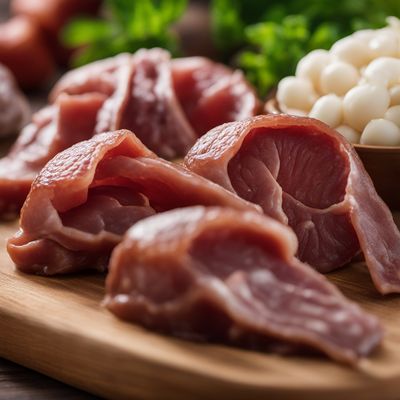
Ingredient
Camel edible offal, non-muscle, other than liver and kidney
Unveiling the Hidden Gems: Exploring the Exquisite Camel Edible Offal
Camel edible offal, non-muscle, other than liver and kidney, encompasses a range of edible organs such as the heart, lungs, spleen, and tripe. With a rich and robust flavor, these offal cuts are often tender and have a slightly chewy texture. The appearance varies depending on the specific organ, ranging from reddish-brown to pale pink. When cooked, camel offal can become tender and succulent, making it a delightful addition to various dishes.
Origins and history
Camel edible offal has a long history of consumption in regions where camels are prevalent, such as the Middle East, North Africa, and parts of Asia. These cultures have recognized the nutritional value and culinary potential of camel offal for centuries, incorporating it into traditional dishes and delicacies.
Nutritional information
Camel edible offal is a nutrient-dense ingredient, providing essential vitamins and minerals such as iron, zinc, vitamin B12, and folate. It is also a good source of protein and contains moderate amounts of fat.
Allergens
There are no known allergens associated with camel edible offal, but individuals with specific food allergies should exercise caution.
How to select
When selecting camel edible offal, look for cuts that are fresh, firm, and free from any unpleasant odor. The color should be vibrant, and the surface should be moist but not slimy. If purchasing from a butcher or market, ensure that the offal is sourced from reputable suppliers.
Storage recommendations
To maintain the freshness and quality of camel edible offal, it should be stored in the refrigerator at temperatures below 40°F (4°C). It is advisable to use it within 1-2 days of purchase to ensure optimal taste and texture.
How to produce
Producing camel edible offal requires specialized knowledge and facilities, making it challenging for amateurs to raise or produce. It is best to source camel offal from trusted suppliers or local markets.
Preparation tips
Before cooking camel edible offal, it is essential to clean and rinse it thoroughly under cold water. Depending on the specific organ, different cooking techniques can be employed, such as grilling, braising, or stewing. Marinating the offal in flavorful spices or acidic ingredients can help tenderize and enhance its taste. It is important to cook camel offal until it reaches a safe internal temperature to ensure food safety.
Culinary uses
Camel edible offal is a prized ingredient in many traditional dishes. It can be used to create hearty stews, flavorful curries, or even grilled skewers. The offal's unique taste and texture add depth and complexity to dishes, making it a favorite among adventurous cooks and those seeking to explore new flavors.
Availability
Camel edible offal is commonly available in regions where camel husbandry is prevalent, such as the Middle East, North Africa, and parts of Asia.
More ingredients from this category

Equine edible offal, non-muscle, other than liver and kidney
Exploring the Hidden Gems of Equine Edible Offal

Sheep edible offal, non-muscle, other than liver and kidney
Exploring the Delicacies of Sheep Edible Offal

Deer edible offal, non-muscle, other than liver and kidney
The Hidden Gems of Deer: Exploring Non-Muscle Edible Offal

Bovine edible offal, non-muscle, other than liver and kidney
The Hidden Gems of Bovine Offal

Wild boar edible offal, non-muscle, other than liver and kidney
Savory Treasures from the Wild

Goat edible offal, non-muscle, other than liver and kidney
The Hidden Gems of Goat: Exploring the Delicacies of Edible Offal

Rabbit edible offal, non-muscle, other than liver and kidney
Unveiling the Hidden Gems: Exploring the Versatile Rabbit Edible Offal

Pig edible offal, non-muscle, other than liver and kidney
Beyond the Ordinary: Exploring the Versatility of Pig Edible Offal